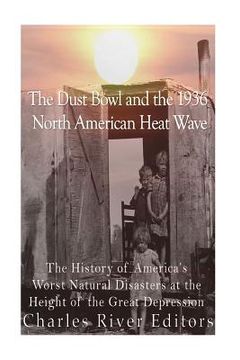The Dust Bowl and the 1936 North American Heat Wave: The History of America's Worst Natural Disasters at the Height of the Great Depression (en Inglés)
Reseña del libro "The Dust Bowl and the 1936 North American Heat Wave: The History of America's Worst Natural Disasters at the Height of the Great Depression (en Inglés)"
*Includes pictures *Includes contemporary accounts *Includes online resources and a bibliography for further reading "People caught in their own yards grope for the doorstep. Cars come to a standstill, for no light in the world can penetrate that swirling murk.... The nightmare is deepest during the storms. But on the occasional bright day and the usual gray day we cannot shake from it. We live with the dust, eat it, sleep with it, watch it strip us of possessions and the hope of possessions." - Avis D. Carlson It is almost impossible to imagine today, but in the late 19th century and early 20th century, there were places where land was cheaper than food and more plentiful than water. During the homesteading period of the 1860s-1880s, the government typically offered land grants of 160 acres to any farmer who could get it cultivated within a certain amount of time. With that much land to make productive and a limited number of years to get it cleared and planted, men would do whatever it took to get their crops in. Of course, these farmers, trying to quickly carve working farms, were more concerned with speed than with the impact on the ground itself. Surviving each year itself was enough work; the future would have to worry about itself. While farmers were planting crops, the seeds were also being sown for a natural disaster once a severe drought hit the prairie land in the 1930s. Due to a lack of proper dryland farming methods, wind erosion and the drought combined to create horrific dust storms that devastated wide swathes of Great Plains and even reached cities on the East Coast like New York City and Washington, D.C. It's estimated that the dust storms affected about 100 million acres during the decade, uprooting not just soil but tens of thousands of people as their farms and families suffered. With farms failing across vast portions of Texas, Oklahoma, New Mexico Colorado and Kansas, those who could no longer support themselves became migrants, moving to other states like California, but the country was still in the throes of the Great Depression. As a result, there was a unique class of suffering that was documented not only in pictures but in graphically realistic novels like John Steinbeck's The Grapes of Wrath. Pictures of abandoned farms that looked like post-apocalyptic ghost towns helped drive the crisis home across the country, to the extent that the Dust Bowl is still well-known 80 years later. As if the destruction of the Dust Bowl wasn't bad enough, conditions were exacerbated by a heat wave in 1936. Ironically, the weather early that year did not exactly suggest that heat would be a problem, as December 1935 was seasonably cold, and February 1936 was downright frigid. In fact, February was the coldest month in the nation's history, with a number of cities recording record low temperatures. As a result, when the weather began to warm up in March and April, people breathed a sigh of relief, but it kept getting warmer, and rain ceased to fall in some areas. By May, there was a crisis building, even as people maintained hope that each rainstorm would end the heat wave. By the end of the summer, the heat wave had killed thousands across the nation, and it was still far from over. Humidity remained low, making the heat somewhat more bearable, but it exacerbated the nationwide drought that kept killing crops. The heat and drought became front page news that even President Roosevelt had to address on a regular basis. The Dust Bowl and the 1936 North American Heat Wave: The History of America's Worst Natural Disasters at the Height of the Great Depression chronicles some of the toughest years in American history. Along with pictures of important people, places, and events, you will learn about the Dust Bowl and the 1936 heat wave like never before.

